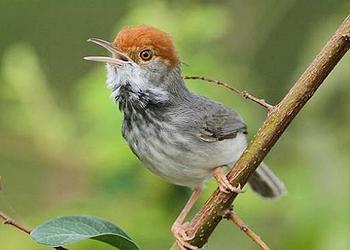
PHNOM PENH, Cambodia, June 27, 2013 (ENS) – There are 1.5 million people living in Cambodia’s capital city, Phnom Penh, so secluded hiding places for a loud-voiced bird are few and far between, you might think. Not so!
Scientists have just discovered a previously undescribed species of bird with distinct plumage and a loud call living right in the city. They have named it the Cambodian tailorbird. Its scientific name, Orthotomus chaktomuk, reflects an old Khmer word meaning four faces.

The Cambodian tailorbird is one of only two bird species found solely in Cambodia. The other, the Cambodian laughing thrush, lives only in the remote Cardamom Mountains.
The wren-sized gray bird with a rufous cap and black throat lives in dense, humid lowland scrub where the Tonle Sap, Mekong and Bassac rivers converge in the city. “Most individuals probably occupy one large contiguous area of habitat in the Tonle Sap floodplain,” the scientists write.
Only fragments of floodplain scrub remain in the city, but larger areas of seasonally flooded scrub persist just outside the city limits where the Cambodian tailorbird is more abundant.
Scientists describe the new bird in a special online early-view issue of the Oriental Bird Club’s journal “Forktail.”
Authors include: Simon Mahood, Ashish John, Hong Chamnan, and Colin Poole of the Wildlife Conservation Society; Jonathan Eames of BirdLife International; Carl Oliveros and Robert Moyle of the University of Kansas; Fred Sheldon of Louisiana State University; and Howie Nielsen of the Sam Veasna Centre.
Mahood began investigating the new bird when co-author John took photographs of what was first thought to be a similar, coastal species of tailorbird at a construction site on the edge of Phnom Penh.
“The modern discovery of an undescribed bird species within the limits of a large populous city – not to mention 30 minutes from my home – is extraordinary,” said Mahood. “The discovery indicates that new species of birds may still be found in familiar and unexpected locations.”
The authors say that the bird’s habitat is declining due to agricultural and urban expansion.

“Most floodplain scrub in Cambodia occupies land suitable for rice cultivation and could be further threatened by changes in ongoing burning, fuel-wood collection, cattle grazing (all of which potentially have a dual role because they also serve to slow succession) and the spread of the invasive plant Mimosa
pigra,” the authors write in their “Forktail” article describing the bird for the first time.
“Ironically, O. chaktomuk might now be dependent on human activity to keep suitable scrubby habitat from becoming forest, since other anthropogenic impacts – eradication of wild ungulates, replacement of domestic animals by machines, water flow/level control, and changes in agricultural practices such as
fallows and cyclical abandonment – have greatly curtailed processes that maintained the scrub,” the scientists write.
But the scientists express concern that the Cambodian tailorbird is likely to lose habitat due to the impacts of hydropower development on the Mekong River and its tributaries.
They cite studies showing that hydropower dams could change the duration and size of the annual flood-pulse, leading to reduction in the extent of seasonally flooded habitats that the bird needs to survive.
“Dam construction will also reduce fish populations (the primary protein source in rural Cambodia), cause changes in flood regime and lead to water shortages in the floodplain,” write the scientists, citing a 2012 study. “These changes will probably lead to additional loss of floodplain scrub owing to expansion of agricultural land for rice production, fish ponds and grazing land for cattle.”
Construction has started on one mainstream lower Mekong dam (Xayaburi, in northern Lao PDR) and numerous tributary dams and “pre-construction” works are thought to have begun on another (Don Sahong) in the far south of Lao PDR. Nine more mainstream dams are planned, according to a statement by the Mekong River Commission in 2011.
The scientists who discovered the Cambodian tailorbird recommend that the species be classified as Near Threatened in the Red List of Threatened Species maintained by the International Union for the Conservation of Nature, IUCN.
They say the Cambodian tailorbird population in the Baray Bengal Florican Conservation Area could benefit from the work of scientists from the Wildlife Conservation Society who are collaborating with local communities and the Forestry Administration to protect the Bengal florican and other threatened birds.
Copyright Environment News Service (ENS) 2013. All rights reserved.
© 2013, Environment News Service. All rights reserved. Content may be quoted only with proper attribution and a direct link to the original article. Full reproduction is prohibited.
